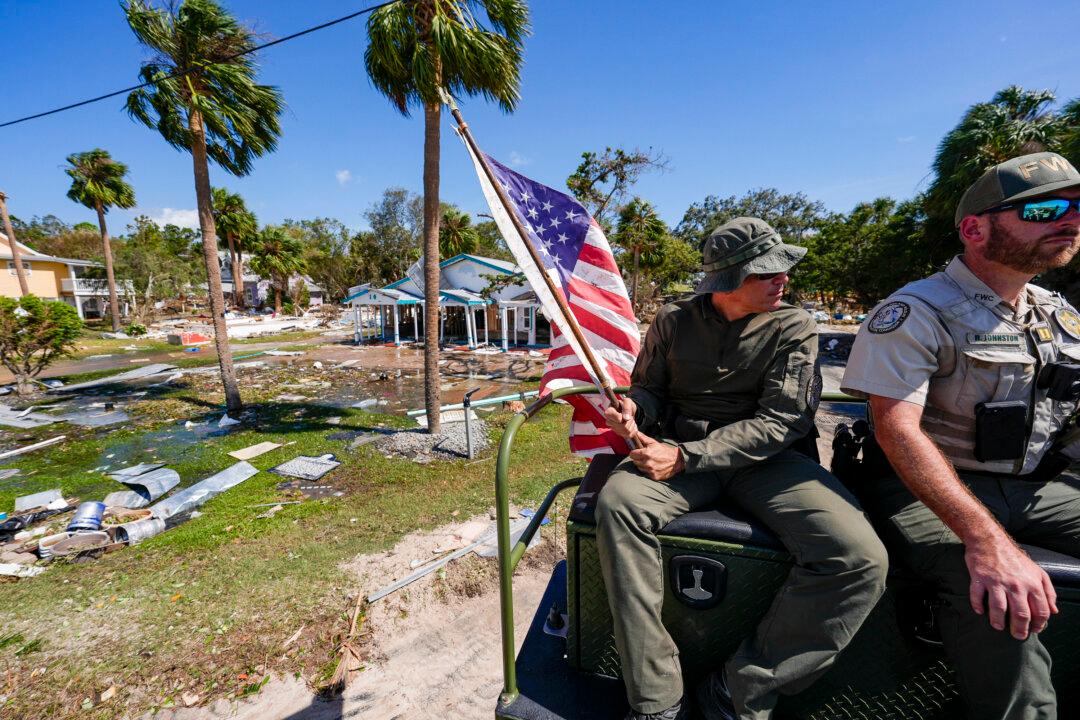TAMPA—Florida Gov. Ron DeSantis said Hurricane Helene’s “monumental storm surge” caused far greater damage than last year’s Idalia.
“Clearly you saw storm surge in excess of 15 feet,” DeSantis said to reporters in Taylor County’s Dekle Beach on the morning of Sept. 28.
“So that is much, much more significant than what we’ve seen in recent storms like Idalia that hit and certainly Debbie, and that is really, really destructive. So, as you look around here, you see some homes that are now just rubble.”
He said some of the damage he saw while flying over the affected coastline on Sept. 27 en route to Cedar Key was “complete obliteration.”
As recovery and emergency response efforts continue across the southeast United States in the aftermath of Hurricane Helene, more than 50 storm-related deaths have been confirmed, and early estimates are that there will be more than $15 billion in damages.
DeSantis confirmed that at least 11 of those storm-related fatalities occurred in the state. However, none of these fatalities occurred in Taylor County, where Helene made landfall as a Category 4 hurricane.
The governor was joined by the executive director of Florida’s Department of Emergency Management, Kevin Guthrie, and Federal Emergency Management Agency (FEMA) Director Deanne Criswell. They expressed their shared desire to put everyone affected into a safe, dry living space, whether that is providing assistance through the state housing repair program or providing full temporary housing in the form of trailers through the state housing program or FEMA’s federal direct housing program.
Guthrie said that trailers were already on their way to Taylor County and portions of Levy County, but he emphasized that they were a temporary solution. Florida building code does not allow permanent travel trailer construction in these areas.
“We want to help you get through that temporary [housing] onto what your permanent housing is going to be,” he said.
Thousands of emergency response missions have been undertaken since Sept. 26, and power has been restored to nearly 2 million customers across the state. On Sept. 27, The Epoch Times reported that more than 1.3 million customers were simultaneously without power. As of 12:30 p.m. on Sept. 28, that number is down to a little more than 425,000.
The governor also confirmed that more than 12,000 miles of roadways have been cleared by more than 800 cut-and-toss crews, and 1,400 bridges have been inspected by 129 inspectors. Major bridges have already reopened, including the Sunshine Skyway and Howard Franklin bridges in Tampa Bay.
However, several roads and areas across the state remain inaccessible, including barrier islands in Pinellas County. Search and rescue missions from Florida’s National Guard, Florida’s State Guard, and local law enforcement are still ongoing.
Other states also experienced devastating effects of Hurricane Helene. The list of fatalities includes people in Georgia, South Carolina, North Carolina, and Virginia.
More than 1 million customers are still without power in South Carolina. Significant power outages had been recorded in the other aforementioned states and in West Virginia, Tennessee, Kentucky, Indiana, and Ohio.
Historic rainfall of more than 11 inches in less than 48 hours was recorded in Atlanta.
Multiple tornadoes were confirmed in North Carolina, and immense rain and landslides have all but cut off access to the western portions of the state.
“All roads in Western North Carolina should be considered closed,” the North Carolina Department of Transportation stated on its website. ”I-40 and I-26 are impassable in multiple locations. Travel in this area for non-emergency purposes is hindering needed emergency response.”
Departing flights out of Asheville Regional Airport in North Carolina were canceled through 4:50 p.m. local time on Sept. 28.
North Carolina’s Gov. Roy Cooper issued a major disaster declaration request for 39 counties and the Eastern Band of Cherokee Indians on Sept. 28, specifically requesting federal public assistance and individual assistance in the storm’s aftermath.
The remnants of now-post tropical cyclone Helene are expected to hover over the Tennessee Valley for the remainder of the weekend.
Moody’s Analytics said it expects $15 billion to $26 billion in property damage.







